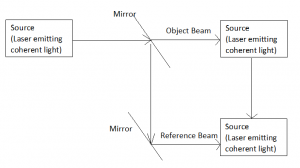Hologram Technology
What is Hologram Technology?
In simple terms, holography or hologram technology is the next stage of photographic technique that records the light scattered from an object, and then projects it as a three-dimensional (3D) object that can be seen without any special equipment. Various kinds of holograms have evolved starting from transmission holograms, rainbow holograms to the recent 3D holograms. The interesting fact about 3D holograms is that it allows seemingly real objects or animations to appear to float in mid-air or stand on a nearby surface. Moreover, it is visible from all sides which means a user can walk around the display, enabling the realistic-looking image to form.
History of Hologram technology
- In the late 1940s, the Nobel prize winner Dennis Gabor invented and developed the holographic method.
- In the year 1962, Yuri Denisyuk was able to achieve practical holograms that recorded the 3D objects.
- Use of rainbow holograms in credit cards started in the 1980s.
- Interactive holographic displays were developed in the year 2009. Later, in the next year, 3D holograms were developed.
- Recently, new hologram technology is developed that can project 3D objects from another location in real-time.
Hologram Working
A beam of laser light is split into two identical beams with one of the split beams (illumination beam or object beam) is directed at the object and then scattered on to the recording medium. The other beam (reference beam) is redirected by the use of mirrors onto the recording medium without going through the object. Photographic plates are commonly used as a recording medium. The two laser beams intersect and interfere with each other at the recording medium. This interference pattern is recorded at the photographic plates.
The original light source is required to view the encoded version of the scene from the recording medium. The laser that is identical to the source laser is used for the reconstruction. The laser beam illuminates the recorded hologram and gets diffracted by the hologram’s surface pattern. This, in turn, produces a light field identical to the captured scene and scatters onto the hologram to reconstruct the object view. The two common types of hologram aerial projection techniques are the computer-generated graphics (CGH) and the spatial light modulator (SLM) technique. A simple block diagram representation of the working principle is given below.
Hologram 3D Reconstruction
There are three major steps involved in a 3D image reconstruction and the steps are as follows.
- Sequential recording from a different perspective or multi-view capture by a set of cameras
- The captured data is converted to a data format suitable for the display.
- Display of data from many SLMs to enlarge the viewing angle
The system requirements for 3D hologram projection in the mid-air consist of a 3D object reconstruction device and an aerial projection device. The reconstruction device creates a 3D holographic image. Further, the aerial projection device projects a 3D hologram in the mid-air.
Electro-holography can project 3D images aerially without any use of multiple projectors and mechanical processing. A spinning mirror system is also used to project a true 3D image. A high-speed video projector is aimed at spinning mirrors that reflect in all directions, making it possible to view images at any angle in 3D. The interference patterns recorded using single-wavelength light leads to a monochromatic hologram. Multiple interference patterns are recorded with different wavelengths to create a colour hologram. Then, holographic projectors use lasers with different wavelengths to illuminate the corresponding interference patterns for their respective colours.
Applications of Hologram Technology
There are many applications of this technology spanning different sectors. Few application examples are listed below.
- Data Storage: Using holographic data storage techniques a large amount of information can be stored inside high-density crystals or polymers. The advantage of this kind of data storage is to use the entire volume of the recording medium, not just its surface. Researchers believe that with the right type of polymers as a recording medium, gigabit per second writing speed and one terabit per second readout is also possible. Therefore, holographic storage has the potential to become the next generation of storage media.
- Security: Secure holograms are extremely difficult to forge because they are replicated from a master hologram. They are found on currencies, credit cards, passports, DVDs, and much other equipment.
- Medicine and Imaging: Hologram technology is on its way to revolutionizing medicine. It has the capability to produce a full-colour 3D hologram of the human body. Students and doctors can visualize the three-dimensional images of complex organs like the brain, heart, liver, lungs, nerves, and muscles. This technology can also help in surgical pre-planning. Before real surgery, the surgeon can fully visualise the entire course of the operation and thereby increase the chances of a successful outcome on patients. Digital holographic microscopy makes it possible to perform cell counting and analysis of subcellular motion deep in living tissue. It also supports simultaneous imaging at different depths.
- Military: The 3D holographic maps of battle spaces is critical for military strategy. Secure military information can be stored using this technology.
- Entertainment and Gaming: Holographic display can be used for creating live performance feel when the subjects are not physically present on the stage. Even, stars from the past can be resurrected to perform with modern artists live on the stage. Holographic display tables can allow real-time multiplayer gaming experience. Few manufacturers are integrating this technology with augmented reality and smartphone display, which can allow portable 3D gaming.
- Education: Hologram technology can drastically improve the educational experience. It can provide interactive digital teaching in schools. This technology can even offer mixed reality by combining digital and real-world information. Students can examine and interact with holographic images to understand complex subjects. For example, they can visualize individual atomic particles and its behaviour, or explore the ruins of ancient heritage monuments in a history class.
